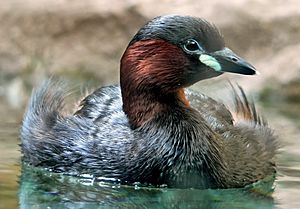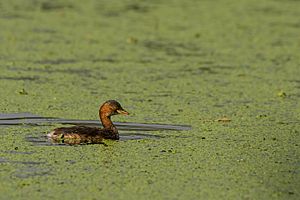Little Grebe facts for kids
The little grebe (Tachybaptus ruficollis), also called the dabchick, is a small water bird. It belongs to the grebe family. The name Tachybaptus comes from ancient Greek words meaning "fast" and "to sink under." Ruficollis means "red-necked" in Latin.
This bird is about 23 to 29 centimeters (9 to 11 inches) long. It is the smallest grebe found in Europe. You can often spot it in open water areas.
Contents
What Does a Little Grebe Look Like?
The little grebe is a small water bird with a pointy beak. In summer, adult birds are easy to spot. They are mostly dark on top. Their neck, cheeks, and sides are a rich reddish-brown color. They also have a bright yellow area at the corner of their beak, called a gape.
When it's not breeding season, or if the bird is young, the reddish-brown color changes. It becomes a dull brownish-grey.
Young Little Grebes
Young little grebes have a yellow beak with a small black tip. They also have black and white stripes on their cheeks and neck. As they get older, their yellow beak turns darker. Eventually, it becomes black when they are adults.
Winter Appearance and Sounds
In winter, the little grebe looks different. It is buff-colored with a darker back and head. Its fluffy rear end helps identify it easily. The little grebe's breeding call sounds like a repeated trill. It goes weet-weet-weet or wee-wee-wee. Some people think it sounds like a horse whinnying!
Where Do Little Grebes Live?
These birds build their nests in small groups. They prefer freshwater lakes with lots of plants. You can find them in Europe, much of Asia (down to New Guinea), and most of Africa.
Most little grebes move to more open water or coastal areas in winter. However, they only travel long distances (migrate) if the water where they live freezes over. Outside of breeding season, they might even appear in small bays along the coast.
How Do Little Grebes Behave?
The little grebe is an excellent swimmer and diver. It hunts for fish and small water creatures underwater. It is very good at using plants in the water to hide.
Nesting and Reproduction
Like all grebes, the little grebe builds its nest right at the edge of the water. This is because their legs are set very far back on their bodies, which makes it hard for them to walk well on land.
A female grebe usually lays four to seven eggs. When an adult bird leaves the nest, it often covers the eggs with weeds. This helps to hide them from animals that might try to eat them. The young birds can swim very soon after they hatch. You might even see the chicks riding on the backs of the swimming adult birds! In India, these birds lay their eggs during the rainy season.
Images for kids
See also
 In Spanish: Zampullín común para niños
In Spanish: Zampullín común para niños















